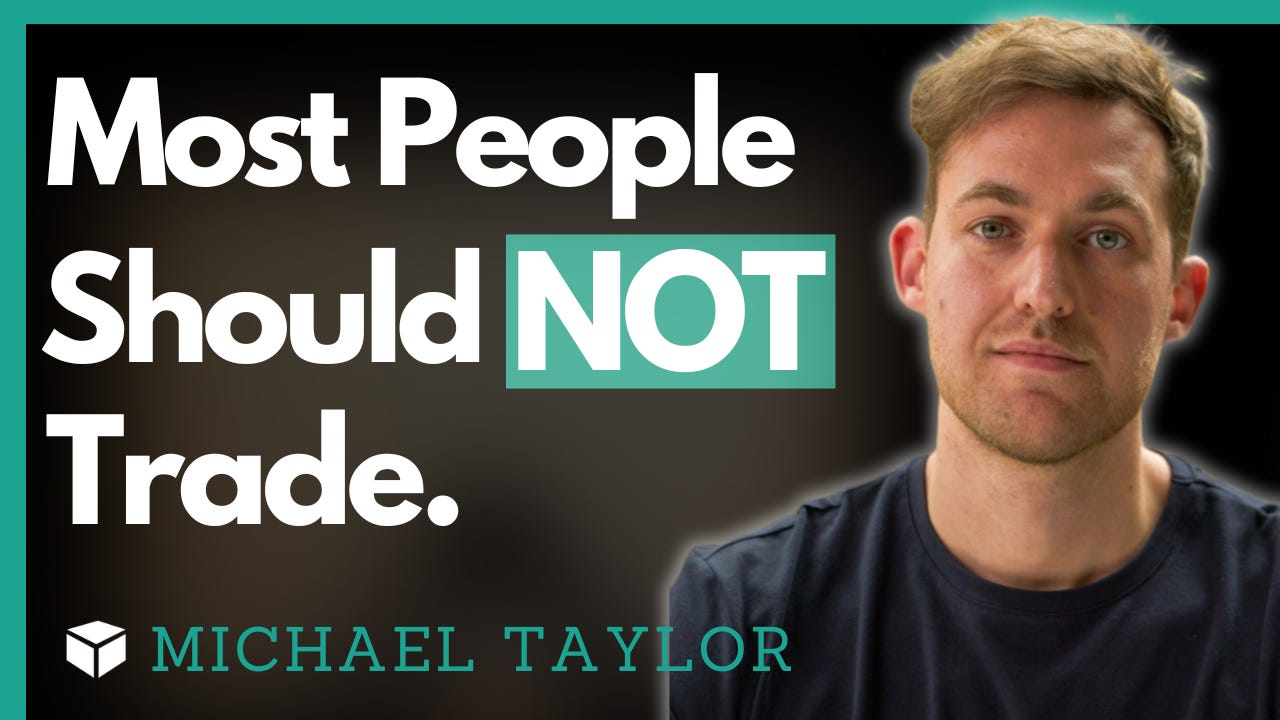Think Differently—Or Settle for Average
How to Make Money Trading UK Stocks
Welcome back!!
This week, we sat down with the founder of Shifting Shares, UK stock trader Michael Taylor.
I came across Michael via his YouTube and Instagram and was immediately drawn to how openly honest he is about trading. I was also super aligned with his advice to traders.
Michael is also very humble.
But don’t be fooled: his story is full of challenges that would break most traders, yet he survived, built a successful trading career and has now helped hundreds of traders along their journey.
Here are my summary notes from our podcast!
Think Differently—Or Settle for Average
“If you're going to buy and do what everyone is doing, you're going to get average results.”
Traders who follow the crowd might as well buy an ETF.
The real opportunity lies in finding inefficiencies, not in mimicking Twitter consensus.
To outperform, you need to consistently ask yourself: “Where is the crowd wrong?” and “Where are the trapped traders?”
Why Averaging Down is a Career-Ender
Michael avoids averaging down completely.
He reminds us that even legendary investors like Bill Miller got wiped out trying to average down into names like Kodak.
“It only takes one position to blow up everything,”
He’s flipped the instinct: rather than adding when price moves against him, he only adds when trades go in his favour.
The idea that buying more when you’re wrong somehow helps you be right later is a dangerous psychological trap.
Respect Drawdowns—They Compound Quickly
Michael reminds us that a 50% loss requires a 100% gain just to get back to even.
For him, that kind of math doesn’t work. He sizes trades based on how much he can lose comfortably, not optimistically.
If you're too emotionally attached to even a small loss—say £50—your size is still too big.
Capital protection and risk management are first, trading is second.
Breakouts Are Still the Foundation
Michael focuses on UK small caps that are breaking out near 26- or 52-week highs with volume.
The key is clean price structure and a lack of overhead supply. He isn’t reinventing trading—he’s executing it well.
He looks for charts where price can move freely because there aren’t sellers waiting to break even.
The longer the consolidation, the better the breakout potential.
Start With the Chart, Then Go Fundamental
Unlike many investors, Michael starts with technicals.
If the chart’s right, then he checks the company: earnings cycle, balance sheet strength, recent news, or industry positioning.
This flips the traditional investing model. He’s not asking “Is this a great company?”—he’s asking “Is this setup ready, and is the story behind it strong enough to support the move?”
Shorting is a Tool, Not a Lifestyle
While most traders glorify shorting, Michael does it selectively—and only when the catalyst is obvious.
He looks for companies with collapsing cash positions and high burn rates.
This isn’t “value shorting”—it’s tactical.
If there’s no hard catalyst, he stays out. And if the timing isn’t tight, he’s not interested.
“You can be right—but not around long enough to see it.”
You Must Own Your Process
Michael learned early not to rely on forums, communities, or gurus.
If he takes a trade, it must come from his process.
The worst feeling in trading is losing money because you followed someone else’s idea.
He gets his news from the Regulatory News Service (RNS) each morning and scans for setups with software. But the final judgment is always his own.
Why UK Small Caps Still Offer Edge
In his view, UK small caps are inefficient and retail-driven.
Many participants are “punters,” not pros. That creates opportunity—if you’re disciplined.
But Michael’s cautious: IPO activity is down, and the market is shrinking.
The edge may fade. For now, though, he’s staying put and exploiting the inefficiencies.
Concluding Thought
Michael’s edge is repeatable: scan for breakouts, validate with fundamentals, structure the trade, manage risk, execute, review. No need for complexity.
As he puts it: “It’s basically a video game of pattern recognition and risk allocation.”
Hope you enjoyed this newsletter, see you next week!
(This newsletter is not investment advice, all views are my own.)



